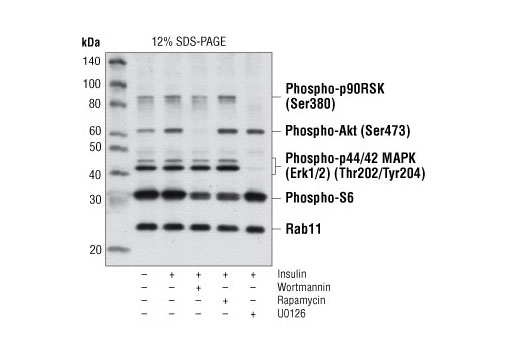WB
H M R
Endogenous
Rabbit
#P27361, #P62491, #P31751, #Q15907, #Q9Y243, #P62753, #P28482, #P31749, #Q15418
5595, 8766, 208, 9230, 10000, 6194, 5594, 207, 6195
Product Information
Storage
Specificity / Sensitivity
Species Reactivity:
Human, Mouse, Rat
Source / Purification
Antibodies are produced by immunizing animals with synthetic peptides. Polyclonal antibodies are purified by protein A and peptide affinity chromatography.
Product Description
Background
Akt, also referred to as PKB or Rac, plays a critical role in controlling the balance between survival and apoptosis (1-3). This protein kinase is activated by insulin and various growth and survival factors, and functions in a wortmannin-sensitive pathway involving PI3 kinase (2,3). Akt is activated by phospholipid binding and activation loop phosphorylation at Thr308 by PDK1 (4) and also by phosphorylation within the carboxy-terminus at Ser473.
Both p44 and p42 MAP kinases (Erk1 and Erk2) play a critical role in the regulation of cell growth and differentiation (5-8). MAP kinases are activated by a wide variety of extracellular signals including growth and neurotrophic factors, cytokines, hormones and neurotransmitters. Activation of MAP kinases occurs through phosphorylation of threonine and tyrosine (202 and 204 of human MAP kinase [Erk1] or 183 and 185 of rat Erk2) at the sequence T*EY* by a single upstream MAP kinase kinase (MEK) (9,10). One of the downstream targets of p44/42 MAPK is p90RSK.
To effectively promote growth and cell division in a sustained manner, growth factors and mitogens must upregulate translation (11,12). Growth factors and mitogens induce the activation of p70 S6 kinase, which in turn phosphorylates the S6 ribosomal protein. Phosphorylation of S6 correlates with an increase in translation, particularly of mRNAs with an oligopyrimidine tract in their 5+ untranslated regions (12).
- Franke, T.F. (1997) Cell 88, 435-437.
- Burgering, B.T. and Coffer, P.J. (1995) Nature 376, 599-602.
- Franke, T. F. et al. (1995) Cell 81, 727-736.
- Alessi, D.R. et al. (1996) EMBO J. 15, 6541-6551.
- Marshall, C.J. (1995) Cell 80, 179-185.
- Hunter, T. (1995) Cell 80, 225-236.
- Hill, C.S. and Treisman, R. (1995) Cell 80, 199-211.
- Cowley, S. et al. (1994) Cell 77, 841-852.
- Sturgill, T.W. et al. (1988) Nature 334, 715-718.
- Payne, D. M. et al. (1991) EMBO J. 10, 885-892.
- Dufner, A. and Thomas, G. (1999) Exp. Cell. Res. 253, 100-109.
- Peterson, R.T. and Schreiber, S.L. (1998) Curr. Biol. 8, R248-R250.
Species Reactivity
Species reactivity is determined by testing in at least one approved application (e.g., western blot).
Western Blot Buffer
IMPORTANT: For western blots, incubate membrane with diluted primary antibody in 5% w/v BSA, 1X TBS, 0.1% Tween® 20 at 4°C with gentle shaking, overnight.
Applications Key
WB: Western Blotting
Cross-Reactivity Key
H: human M: mouse R: rat Hm: hamster Mk: monkey Vir: virus Mi: mink C: chicken Dm: D. melanogaster X: Xenopus Z: zebrafish B: bovine Dg: dog Pg: pig Sc: S. cerevisiae Ce: C. elegans Hr: horse GP: Guinea Pig Rab: rabbit All: all species expected
Trademarks and Patents
Limited Uses
Except as otherwise expressly agreed in a writing signed by a legally authorized representative of CST, the following terms apply to Products provided by CST, its affiliates or its distributors. Any Customer's terms and conditions that are in addition to, or different from, those contained herein, unless separately accepted in writing by a legally authorized representative of CST, are rejected and are of no force or effect.
Products are labeled with For Research Use Only or a similar labeling statement and have not been approved, cleared, or licensed by the FDA or other regulatory foreign or domestic entity, for any purpose. Customer shall not use any Product for any diagnostic or therapeutic purpose, or otherwise in any manner that conflicts with its labeling statement. Products sold or licensed by CST are provided for Customer as the end-user and solely for research and development uses. Any use of Product for diagnostic, prophylactic or therapeutic purposes, or any purchase of Product for resale (alone or as a component) or other commercial purpose, requires a separate license from CST. Customer shall (a) not sell, license, loan, donate or otherwise transfer or make available any Product to any third party, whether alone or in combination with other materials, or use the Products to manufacture any commercial products, (b) not copy, modify, reverse engineer, decompile, disassemble or otherwise attempt to discover the underlying structure or technology of the Products, or use the Products for the purpose of developing any products or services that would compete with CST products or services, (c) not alter or remove from the Products any trademarks, trade names, logos, patent or copyright notices or markings, (d) use the Products solely in accordance with CST Product Terms of Sale and any applicable documentation, and (e) comply with any license, terms of service or similar agreement with respect to any third party products or services used by Customer in connection with the Products.
